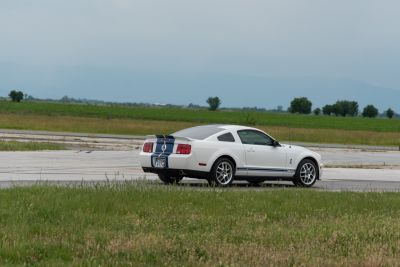 1967 Chevrolet Camaro I Dimensions, Size & Specs
1967 Chevrolet Camaro I Dimensions, Size & SpecsMeasurements of the 1967 Chevrolet Camaro I, engineered for optimal performance and comfort
| Dimensions | |
|---|---|
| Length: | 4691 mm184.7 in15.4 ft |
| Width: | 1842 mm72.5 in6.0 ft |
| Height: | 1295 mm51.0 in4.2 ft |
| Ground Clearance: | 140 mm5.5 in0.5 ft |
| Trunk Capacity: | 235 liter8.3 cu ft |
| Weight Specifications | |
| Curb Weight: | 1315-1424 kg2899-3139 lbs |
The 1967 Chevrolet Camaro I represents the dawn of Chevrolet's iconic muscle car lineage, produced between 1966 and 1968 as a sleek two-door coupe designed to compete in the burgeoning pony car market. This first-generation Camaro features a length of 4691 mm (184.7 inches), a width of 1842 mm (72.5 inches), and a height of 1295 mm (51 inches), showcasing a low, aggressive stance typical of American muscle cars of the era. Weighing between 1315 and 1424 kg (2899 to 3139 lbs), the Camaro I strikes a balance between muscular heft and nimble handling. Its luggage capacity is 235 liters (8.3 cubic feet), adequate for modest cargo, reflecting the car's sporty and driver-focused design rather than utility. Additionally, the ride height or ground clearance of 140 mm (5.5 inches) complements its low profile, aiding in stability and road grip. The Camaro I was celebrated not only for its performance but also for its competitive dimensions that offered a blend of road presence and drivability, making it a standout classic in the muscle car era.
Discover the standout features that make the 1967 Chevrolet Camaro I a leader in its class
Have a question? Please check our knowledgebase first.
The 1967 Chevrolet Camaro I Coupe has exterior dimensions measuring 4691 mm (184.7 inches) in length, 1842 mm (72.5 inches) in width, and stands 1295 mm (51.0 inches) tall. These dimensions reflect its classic muscle car proportions, providing a sporty yet somewhat compact profile compared to modern vehicles. The low height contributes to a sleek appearance and improved aerodynamics, while the width ensures a stable, planted stance on the road.
The curb weight of the 1967 Chevrolet Camaro I ranges between 1315 kg (2,900 lbs) and 1424 kg (3,140 lbs), depending on the specific model and options equipped. This moderate weight for a muscle car of its era allows it to balance performance and handling. The relatively light curb weight contributes to nimble handling and decent acceleration when paired with its range of powertrains, making the Camaro a responsive and engaging vehicle to drive for its time.
The 1967 Chevrolet Camaro I provides a luggage capacity of 235 liters (approximately 8.3 cubic feet). While this is modest by modern standards, it is typical for a compact muscle coupe from the late 1960s. The trunk offers enough space for essential luggage or small groceries, but larger or bulkier items might be challenging to fit. For everyday use, the Camaro’s trunk is sufficient for weekend getaways or daily errands but may not accommodate extensive cargo needs.
The 1967 Chevrolet Camaro I has a ground clearance of 140 mm (5.5 inches), which is relatively low compared to modern vehicles. This low ride height is typical for muscle cars aimed at improving handling dynamics and reducing air resistance. The reduced ground clearance enhances the car’s stability at higher speeds by lowering the center of gravity, but it also means the Camaro may be less suited for rough or uneven road surfaces, requiring careful navigation over speed bumps or steep driveways.
Yes, the 1967 Chevrolet Camaro I will typically fit into a standard residential garage. With a length of 4691 mm (184.7 inches) and a width of 1842 mm (72.5 inches), the Camaro’s dimensions fall within the common size parameters for garages, which generally accommodate vehicles up to around 6 meters (approximately 20 feet) long and 2.5 meters (8.2 feet) wide. Careful clearance should be observed particularly with width and height, especially when considering any aftermarket modifications or roof racks.
The 1967 Chevrolet Camaro I marked the first model year of the Camaro generation, produced starting in 1966, so it does not have a direct predecessor Camaro model prior to it. It was Chevrolet's response to the Ford Mustang and helped define the muscle car coupe segment. As the original generation, the 1967 model set the standard size with its 4691 mm length, 1842 mm width, and 1295 mm height. Compared to competitor earlier muscle cars, it was competitive in size—offering a blend of sporty compactness with adequate space and style.
Compared to similar muscle cars from the late 1960s, such as the Ford Mustang and Pontiac Firebird, the 1967 Chevrolet Camaro I is quite similar in overall dimensions. The Camaro is slightly longer than the first-generation Ford Mustang, which measured approximately 4570 mm (180 inches) in length, but is comparable in width and height. The Camaro’s sleek, low profile and relatively moderate width contribute to its sporty stance, while its curb weight, between 1315 and 1424 kg, generally places it in the same range as its muscle car peers, balancing size and performance for a competitive offering.
The 1967 Chevrolet Camaro I, with its curb weight between 1315 kg (2,900 lbs) and 1424 kg (3,140 lbs) and aerodynamic dimensions, offered a range of powerful engine options that leveraged its relatively light weight and compact size for impressive muscle car performance. Engine options included inline sixes and V8s ranging from 4.1L straight-six up to big-block 7.4L V8s in specific models, allowing for strong acceleration and sporty handling. The Camaro’s size and weight provided a balanced platform that was both responsive and stable, making it a favorite among enthusiasts.
As a classic muscle coupe, the 1967 Chevrolet Camaro I emphasizes sporty design over spacious interior dimensions. Its compact exterior size translates to a snug cabin, primarily accommodating four passengers with bucket seats up front and a small rear bench. Headroom and legroom are modest, reflective of the car’s 1295 mm (51.0 inches) height and sporty sloped roofline. While front seats provide a supportive, driver-focused setup, rear seating space is best suited for shorter trips or smaller passengers due to limited legroom.
With a ground clearance of 140 mm (5.5 inches), the 1967 Chevrolet Camaro I exhibits a low stance that bolsters road grip and handling on smooth, paved surfaces common in urban areas. This height is optimal for minimizing drag and enhancing high-speed performance. However, the relatively low clearance can pose challenges on rough rural roads, uneven terrain, or in scenarios involving speed bumps and steep inclines. Owners need to exercise caution to avoid scraping the undercarriage, particularly when carrying heavy loads or modifying the suspension.
Discover similar sized cars.

| Production: | 1994-1999 |
|---|---|
| Model Year: | 1994 |
| Length: | 4631 mm182.3 in |
| Width: | 1820 mm71.7 in |
| Height: | 1268 mm49.9 in |

| Production: | 1993-2000 |
|---|---|
| Model Year: | 1993 |
| Length: | 4745 mm186.8 in |
| Width: | 1924 mm75.7 in |
| Height: | 1330 mm52.4 in |

| Production: | 2017-present |
|---|---|
| Model Year: | 2018 |
| Length: | 4760-4770 mm187.4-187.8 in |
| Width: | 2168 mm85.4 in |
| Height: | 1345 mm53.0 in |

| Production: | 2006-2009 |
|---|---|
| Model Year: | 2006 |
| Length: | 4765-4775 mm187.6-188.0 in |
| Width: | 1877 mm73.9 in |
| Height: | 1365-1407 mm53.7-55.4 in |
